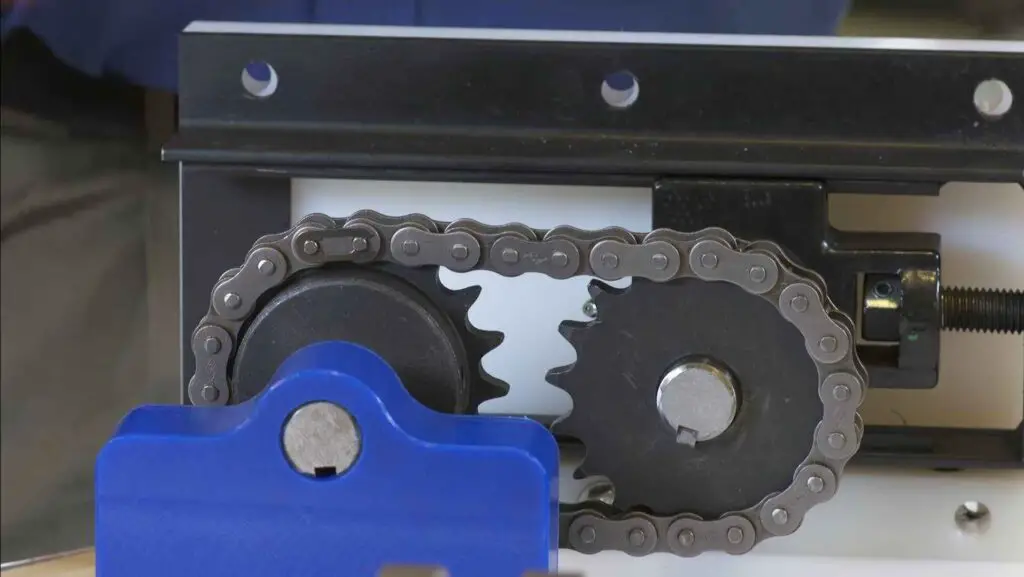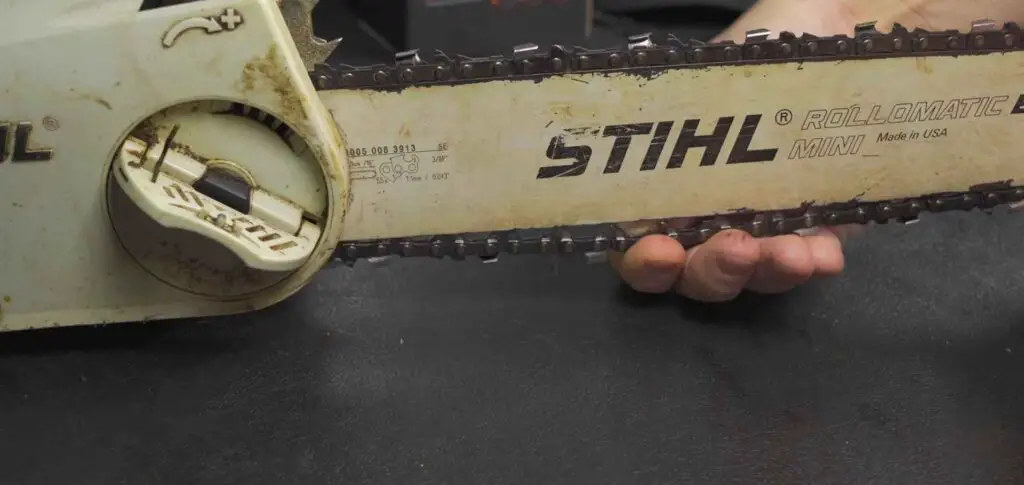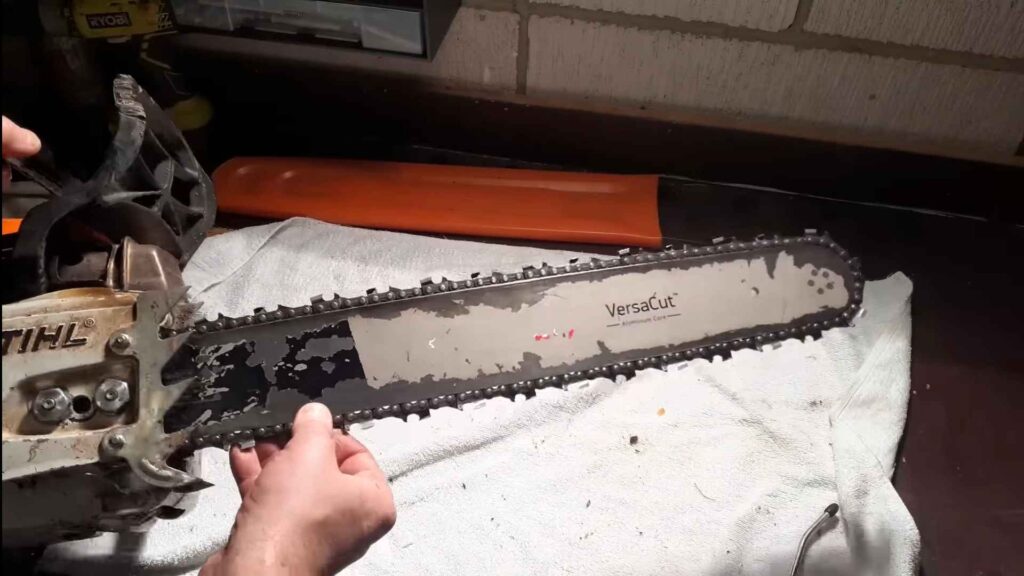A bad chainsaw sprocket can be identified through signs such as worn-out teeth, damaged bearings, and loose chains. Chainsaws are an essential tool for many who work in the forestry industry or enjoy outdoor activities.
However, a poorly maintained chainsaw can cause potential hazards and harm to the user. A chainsaw sprocket serves as a critical component of the chainsaw that enables the chain to rotate around the guide bar.
A bad chainsaw sprocket can be easily identified through a few signs such as worn-out teeth, damaged bearings, and loose chains.
As a user, it is essential to recognize these signs to avoid accidents and ensure that the chainsaw performs optimally. This article will explore the signs of a bad chainsaw sprocket and provide recommendations to remedy the issue.

Worn Teeth
Chainsaws with worn sprocket teeth can cause problems for your equipment’s performance. Identifying the signs of a bad chainsaw sprocket can allow you to fix the issue to prevent further problems promptly.
How To Examine The Sprocket Teeth For Wear
To ensure optimal chainsaw performance, regularly examining your machine’s sprocket teeth is essential. Here are some ways to identify if the teeth are worn:
- Check for visible signs of wear and tear, including chips, cracks, and discoloration.
- Inspect the depth of the teeth’s grooves and determine whether they have worn past the recommended 1/4″ depth.
- Observe the chain’s tension; if it loosens frequently, it may indicate that the sprocket teeth have worn away.
Effects Of Worn Teeth On Chainsaw Performance
The sprocket is one of the most critical components in a chainsaw. Worn teeth could lead to several problems, including:
- Reduced cutting efficiency: Worn teeth cause the chain to slip, decreasing its engagement with the guide bar, resulting in reduced cutting performance.
- Chain jumping out of place: When the chain detaches from the sprocket during operation, it can cause severe damage to the chainsaw, leading to costly repairs.
- Increased wear and tear: A bad sprocket can put excess stress on other parts of the chainsaw such as the bar, blades, and engine, causing them to wear out faster.
Repair Options For Worn Teeth
Fortunately, you can repair a bad chainsaw sprocket, and you have several options to do so:
- Replace the sprocket: The most common remedy for replacing worn sprocket teeth is to replace the entire sprocket.
- File worn teeth: If the sprocket wears gradually and does not require a complete replacement, you can file the teeth to restore them to their original shape.
- Use a chainsaw with a replaceable sprocket: With this option, you can replace only the worn-out sprocket teeth with a new one without having to replace the entire sprocket.
Worn-out sprocket teeth can lead to severe chainsaw problems if left unaddressed. Check your chainsaw regularly for signs of wear and tear, and promptly replace any worn-out sprockets with new ones to keep your machine functioning for longer.
Chainsaw Chain Jumping
Chainsaws are essential for many industries, ranging from forestry to construction. However, a chainsaw can break down over time like any mechanical device. One common issue is a chain jumping off the sprocket, which can pose a significant safety risk to the operator.
In this blog post section, we’ll explore the causes, symptoms, and possible fixes for a chainsaw chain jumping off the sprocket.
Causes And Symptoms Of A Chain Jumping Off The Sprocket

Several issues can cause a chainsaw chain to jump off the sprocket. Here are some of the most common causes:
- Worn-out sprocket: The sprocket can wear out over time, leading to the chain jumping off. When the sprocket teeth become too worn, they can no longer grip the chain properly.
- Loose or damaged drive links: When the drive links on the chain become loose, they can disengage from the sprocket. Similarly, a damaged or bent drive link may not engage properly, leading to the chain jumping off.
- Incorrect chain tension: Chainsaw chains must be adjusted to the correct tension. When the chain is too loose, it can easily jump off the sprocket.
- Dirty or worn drive sprocket bearings: When they become dirty or worn, they may not spin freely, making it difficult for the chain to move smoothly.
Here are some of the common symptoms of a chainsaw chain jumping off the sprocket:
- The chainsaw makes a grinding or clunking noise when in use.
- The chainsaw chain seems to be slipping or jumping off frequently.
- The cut created by the chainsaw is uneven or crooked.
Importance Of Immediate Repair
A chainsaw chain jumping off the sprocket can be a severe safety hazard. If the chainsaw is in use when this happens, the operator can quickly lose control, leading to accidents and injuries.
Immediate repair is essential to ensure the continued safe operation of the chainsaw.
Also, leaving a loose or worn chain unaddressed can further damage the chainsaw.
How To Fix A Chain Jumping Off The Sprocket
Here are the steps to follow to fix a chain jumping off the sprocket:
- Check the sprocket for wear and tear. Replace the sprocket if it is worn beyond the recommended limit.
- Inspect the chain for any damage or bent drive links. Replace the chain if necessary.
- Adjust the chain tension to the recommended level. Be sure not to make it too tight or too loose.
- Inspect the drive sprocket bearings for dirt or wear. Clean or replace the bearings if necessary.
- Assemble the chainsaw and test the chain tension to make sure it is correct.
A chainsaw chain jumping off the sprocket is a common issue that can be dangerous if left unaddressed. By understanding the causes and symptoms of this problem, operators can take the necessary steps to address the issue and ensure the continued safe operation of the chainsaw.
Remember always to practice safety when working with any machinery and use proper protective gear at all times.
Excessive Noise During Operation
Chainsaws are a significant investment, so you want them to function effectively for a long time. However, various issues can arise with time, and a noisy sprocket is one of them.
You’ll want to know if your chainsaw sprocket is making excessive noise during operation.
We’ll discuss the causes and characteristics of noisy sprockets, when to replace a noisy sprocket, and diy steps to replace a noisy sprocket.
Causes And Characteristics Of Noisy Sprockets
A noisy chainsaw can be an indication of a bad sprocket. Some of the reasons why sprockets can become noisy include:
- Misaligned sprocket: If the sprocket is not aligned perfectly, it can create noise when the chainsaw is working.
- Worn-out sprocket: A worn-out sprocket can be a result of continuous use, making it loose and causing excessive noise.
- Dirty sprocket: The accumulation of dirt and sawdust inside the chainsaw can cause noises and affect the sprocket’s performance.
The following are some of the characteristics of a noisy chainsaw:
- Irregular sounds: A worn or misaligned sprocket produces an irregular sound during the operation.
- Grinding sound: Excessive noise while using a chainsaw can also sound like grinding.
- Vibration: A faulty sprocket will cause the chainsaw to vibrate excessively.
When To Replace A Noisy Sprocket

Replacing a noisy sprocket as soon as possible is essential to prevent further damage. Failure to replace it can lead to more severe equipment damage. Here are some signs that indicate that you need to replace a noisy sprocket:
- Chain derails frequently: If the chain keeps derailing, it could be a sign of a worn-out sprocket.
- Difficulty in starting chainsaw: Issues starting the chainsaw can indicate a damaged sprocket.
- Reduced cutting power: If the chainsaw can’t cut wood as it used to before, it’s time to replace the sprocket.
Diy Steps To Replace A Noisy Sprocket
If you have the skills and tools required, you can replace the noisy sprocket yourself. Here are some dit steps to follow when replacing a noisy sprocket:
- Disconnect the spark plug and remove the bar and chain from the chainsaw.
- Remove the sprocket cover and the sprocket itself from the chainsaw.
- Clean any dirt and dust to ensure the area is clean and dry.
- Install the new sprocket and tighten the screws to secure it.
- Replace the sprocket cover and ensure it’s fastened tightly.
- Reinstall the bar and chain and connect the spark plug.
Detecting a noisy sprocket can be a challenge, but the above information will assist you in finding the problem and replacing it. With diy steps to replace the noisy sprocket, you can quickly get your chainsaw back to its proper working condition.
Remember to keep track of the chainsaw’s performance and maintain it regularly to prevent future issues.
Unusual Vibrations
How A Bad Chainsaw Sprocket Causes Vibration
The sprocket is a crucial part of a chainsaw’s cutting mechanism. A damaged or worn-out sprocket can cause your chainsaw to vibrate excessively, leading to several issues. Here are the main reasons why a bad chainsaw sprocket can cause vibrations:
- Poor clutch engagement: A damaged sprocket can lead to poor engagement with the clutch. The clutch mechanism controls the speed of your chainsaw’s chain, and a damaged sprocket can cause the chain to spin faster or slower than intended, leading to increased vibration.
- Misaligned teeth: Sprocket teeth that are misaligned wear the chain unevenly, which can affect the chainsaw’s balance, leading to increased vibrations.
- Worn-out teeth: The sprocket’s teeth can wear out over time, leading to a loose or wobbly fit with the chainsaw’s chains. A loose sprocket can cause the chains to move unevenly, increasing vibrations.
Signs Of Excessive Vibration
If you notice your chainsaw vibrating excessively, you should investigate the cause immediately. Some signs of excessive vibration caused by a bad chainsaw sprocket are:
- Strange noises: A damaged sprocket can cause strange noises, such as grinding, rattling, or clicking sounds, as the chainsaw vibrates.
- Increased wear and tear: Excessive vibrations can cause wear and tear to other parts of the chainsaw, such as the clutch, guide bar, and chain.
- Reduced cutting performance: A vibrating chainsaw is difficult to control, which can affect the quality and speed of your cuts.
Repair Options For High Vibration
A vibrating chainsaw is not only irritating, but it can also be dangerous. Here are some repair options for high vibration:
- Replace the sprocket: If the sprocket is damaged or worn-out, replacing it with a new one should solve the problem.
- Check for misalignment: Ensure that the sprocket’s teeth are clean and properly aligned with the chainsaw’s chain.
- Replace the chainsaw chain: If the chainsaw chain is worn-out or damaged, it can cause excessive vibrations. Replacing it with a new one should solve the problem.
- Clean the chainsaw: Build-up of debris or sawdust can cause vibrations. Ensure that you clean your chainsaw thoroughly after use.
To sum up, a bad chainsaw sprocket can cause unusual vibrations and lead to several issues.
Check for signs of excessive vibrations, and immediately investigate the cause. Repair options include replacing the sprocket, checking for misalignment, replacing the chainsaw chain, or cleaning the chainsaw.
Frequently Asked Questions For Signs Of A Bad Chainsaw Sprocket
How Do I Know If My Chainsaw Sprocket Is Bad?
If you notice wear on the teeth, excessive noise while idling, chain slipping, or reduced cutting speed, it might be time to inspect your chainsaw sprocket. A damaged or worn-out sprocket can also cause a reduction in the power of your chainsaw.
Can I Continue Using My Chainsaw With A Bad Sprocket?
Continuing to use a chainsaw with a bad sprocket could lead to further damage to the sprocket or other parts of the chainsaw and put you at risk for accidents. If you suspect your sprocket is bad, stop using it and inspect the sprocket for wear or damage.
How Often Should I Replace My Chainsaw Sprocket?
The lifespan of a chainsaw sprocket depends on the frequency and type of use. If you use your chainsaw regularly, it is recommended that you replace the sprocket every one to two years or after every 4 to 5 chain replacements.
Proper maintenance and cleaning can help prolong the life of your sprocket.
Conclusion
The chainsaw sprocket is a crucial component in the functioning of a chainsaw. As users continue to use their chainsaws, they should be vigilant about checking for signs of wear and tear on the sprocket.
If left unnoticed, a bad sprocket can lead to bigger and more expensive problems, such as damage to the chainsaw’s engine and a shorter lifespan for the chainsaw.
Signs of a bad sprocket can manifest in a variety of ways, including visible wear and tear, loose chains, and difficulty starting the chainsaw.
It’s important to address any problems with the chainsaw sprocket as soon as they are noticed, through regular maintenance or replacement of the part.
By keeping an eye out for these signs and taking preventative measures, users can prolong the life of their chainsaw and ensure it is functioning at optimal levels for each use.